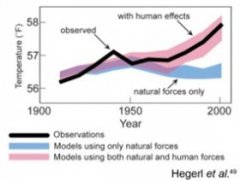All about climate change
What is the evidence that proves the climate is changing?
The global average temperature increased by more than 1.4°F over the last century. In fact, according to the National Oceanic and Atmospheric Administration (NOAA), the decade from 2000 to 2010 was the warmest on record, and 2010 was tied with 2005 as the warmest year on record. Rising global temperatures have also been accompanied by other changes in weather and climate. Many places have experienced changes in rainfall resulting in more intense rain, as well as more frequent and severe heat waves. The planet's oceans and glaciers have also experienced changes: oceans are warming and becoming more acidic, ice caps are melting, and sea levels are rising. All of these changes are evidence that our world is getting warmer.
Are human activities or natural variations in climate responsible for the climate change being observed today?
The Earth does go through natural cycles of warming and cooling, caused by factors such as changes in the sun or volcanic activity. This has been closely examined, and the warming we have seen in the past 50 years cannot be explained by natural factors alone. This figure illustrates one piece of evidence that shows that recent global warming is primarily a result of greenhouse gas emissions from human activities.
 View enlarged image
View enlarged image
This figure shows the observed average global temperatures from 1900 to 2000 (black line) along with the temperature ranges predicted by climate models. The blue band shows the expected temperature range based on climate models that account only for natural forces. The pink band represents the temperature range predicted by climate models that also include emissions of greenhouse gases from human activities. The recent increase in average global temperatures aligns with the predicted temperatures from the model that includes the greenhouse gas emission.
Source: USGRCP 2009
Is climate change influenced more by human activities and excess greenhouse gases or changes in the sun's energy?
The sun has natural periods of warming and cooling. With satellites, scientists have measured fluctuations in the sun's energy and found that these recent variations have been small in comparison to human influences in the last several centuries, with no increase in solar energy in the past 50 years. Thus, changes in the sun's energy cannot explain the warming we have seen over the past several decades. In contrast, the warming we are observing is consistent with the warming properties of carbon dioxide and other heat-trapping gases that we are adding to the atmosphere.
How can carbon dioxide hurt us?
Carbon dioxide is a necessary ingredient for plants to perform photosynthesis, and a critical component of our atmosphere. However, you can have too much of a good thing. The excess carbon dioxide we are adding to the atmosphere increases global temperatures, leading to climate changes that can harm plants, animals, and humans.


 Our goal is to aggregate and amplify critical climate change stories as a means to move the national conversation forward on all aspects of this crucial issue.
Our goal is to aggregate and amplify critical climate change stories as a means to move the national conversation forward on all aspects of this crucial issue.